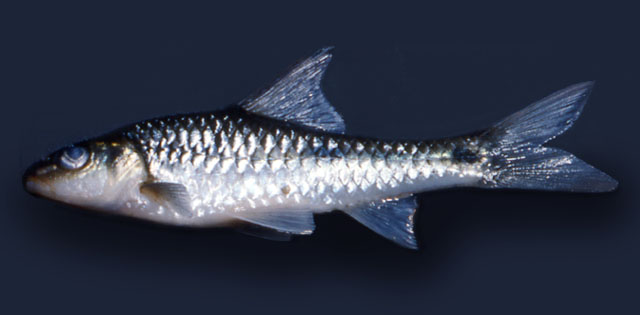| Cyprinidae (Minnows or carps), subfamily: Smiliogastrinae |
| 8.13 cm SL (male/unsexed) |
|
pelagic; freshwater |
| Africa: known from its type locality: River Via, St. Paul's River system, Liberia (Ref. 43268, 81282). |
|
Dorsal spines (total): 1-1; Dorsal soft rays (total): 11-11; Anal soft rays: 8-8. Diagnosis: last simple dorsal-fin ray denticulate on hind margin; gape of mouth not extending beyond vertical line from anterior eye margin; scale formula 4.5/28-29/3.5; 2.5 scales between lateral line and pelvic-fin base; 12 scales around caudal peduncle; 8 branched dorsal fin rays; two pairs of short barbels; anterior barbel not reaching to anterior margin of eye/not extending beyond centre of eye; posterior barbel not extending beyond centre of eye/reaching to, or extending beyond, posterior half of eye; lateral line complete and more or less straight; maximum reported size 81 mm SL (Ref. 81282). Elongate first infraorbital element (= lachrymal) (Ref. 43268).
Description: body moderately compressed; snout blunty pointed in profile; cephalic pit lines well developed and present in series of rows on cheek, and on dorsal surface of head between orbits; pectorals long and tips overlap with origin of pelvics; dorsal longer than head; gill rakers weakly developed on first gill arch (Ref. 43268). Mouth subterminal, its angle not reaching the vertical of anterior margin of eye; last unbranched spinous ray of dorsal fin is strongly ossified basally with serrated posterior border; D:IV,8; A:III,5; P:I,14; V:I,7 (Ref. 43628, 81282).
Coloration: dorsal body surface dark; 3-4 black, midlateral spots, 1st lies little above lateral line canals of the 6th and 7th scales and slightly before vertical of origin of dorsal fin; 2nd overlies canals of 14th and 15th lateral lines scales and lies little behind vertical of last dorsal fin ray; 3rd at base of caudal peduncle; 4th, smaller spot, also present in most individuals between 2nd and 3rd spots, but not always present on both sides of fish; body silvery (Ref. 43628, 81282). Dorsal, caudal and pectoral fins slightly pigmented and a dusky grey in color, while pelvic and anal fins are clear; juveniles lack much of dorsal pigmentation of the adults (Ref. 43268). |
|
|
Critically Endangered (CR); Date assessed: 15 January 2020 (B2ab(iii)) Ref. (130435)
|
| harmless |
Source and more info: www.fishbase.org. For personal, classroom, and other internal use only. Not for publication.

